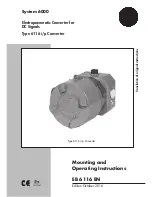
24
The displayed syntax includes register designation
headers appropriate to each entry. Any single register
may be interrogated by typing its header and a single
question mark. For example, type
SPEED?
8
to request
a confirmation that the encoder port speed is indeed set
to 9600 baud.
Updating
Registers
Using the
Terminal Utility
In these programming instructions the
exact
ASCII syntax to be en-
tered on the keyboard will be given in the font used in the following
example for the Radio Text field:
TEXT=VISIT US AT THE
COUNTY FAIR AND ON THE WEB AT www.wtop989.com
8
. Spe-
cifically, the word TEXT followed by the equal sign and the message
to be sent, followed by the Enter key. The symbol
8
denotes the
Enter key.
The illustration here shows this
Radio Text field entry. Note that
the terminal utility does not
word-wrap the text, but each
character will be seen as it is en-
tered. When the Enter key is pressed after the text has been typed-
in, the reply
OK
indicates that data has been received and saved in
encoder RAM. Note that the answerback response is always a cou-
ple of lines below the entry.
The terminal utility is not intended for use as a text editor, in that
typing errors are not easily corrected in this window. If you make a
mistake, just press Enter and start over. Your mistake will be sent
and saved in 720 memory, but if you update the error promptly it s
doubtful that anything untoward will be noticed. This
illustrates the advisability of using the 720 software,
rather than the terminal utility, for entering text.
If improper syntax or an invalid entry is made, the en-
coder will respond back with a
NO
. This is shown for a
number of improper entries here. The last entry was
an attempt to set the PI register by simply typing-in
call letters. This won t work. The 720 PI calculator is
in the software routine, which is not available when
















































